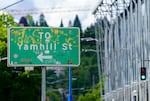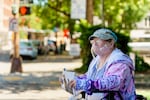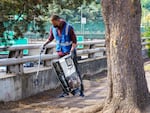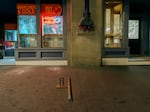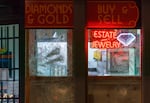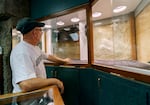Downtown Portland has had a hell of a year. The coronavirus pandemic emptied offices. Protesters filled the streets after George Floyd’s murder, demanding racial justice. Tents lined city sidewalks, sheltering people with no place to go in the middle of a plague. Vandals struck at night — and still do.
OPB is following downtown’s recovery as it emerges from the pandemic, starting with some basic questions: How do you measure the challenge facing downtown? And what does recovery look like?
Because from street corners to office towers, everyone who interacts with downtown Portland has their own way to gauge its health.
OPB is following downtown Portland as it emerges from the pandemic. Do you live or work downtown? Tell us about your questions or experiences via e-mail at questions@opb.org.
Downtown recovery: one view from the street
Belinda Estermyer sat at a corner of SW 2nd Avenue the other day, holding up Street Roots newspapers.
“Hoping and praying somebody will come by and buy one,” she said.
For months after the virus hit, there were no papers to sell. Street Roots suspended its print edition, for the safety of its vendors and customers. Now, Estermyer is selling far fewer papers than she used to because downtown is so quiet. For her, that means less money to help pay for medication.

Belinda Estermyer says she is selling far fewer papers than she used to because downtown is so quiet. For her, that means less money to help pay for medication.
Kristyna Wentz-Graff / OPB
On this day, a few regular customers came by. Then a man walked up pushing a stroller and carrying a machete on his back. He gave her a dollar and said he used to sell papers too.
Estermyer has watched more tents appear near the low-income housing where she lives, and seen more people experiencing homelessness.
She has her own metric for recovery. She pointed down the street, to one of many boarded-up buildings.
“That looks awful over there with them windows boarded up. I hate seeing that,” she said. “I mean, it makes me think that the town is dead. And I do mean dead.”
Recovery, to her, means the boards come off.
So, that’s one way to measure the health of downtown — in boarded windows and shattered glass.
Downtown recovery: a shop-level view
On bright spring days, downtown feels more alive.
The farmers’ markets are bustling. Firefighters line up for morning coffee at Stumptown. Hundreds of volunteers have rolled up their sleeves, collecting almost 30,000 pounds of trash since September, according to SOLVE.
“I want to do whatever I can to make Portland what it used to be,” said volunteer Linda Rankin at a cleanup last month.

Larry Purtle of Portland picks up trash from beneath a bush along SW 13th Avenue last month, taking part in the ninth Downtown Volunteer Litter Cleanup Day.
Kristyna Wentz-Graff / OPB
Foot traffic has been picking up at Pioneer Place mall — another sign of nascent recovery. In January, mall visits were down almost 80% from the same month in 2019, according to the analytics firm Placer.ai. In May, they were down just 50% from 2019.
But as more people stroll into Pioneer Place, they’re still walking past the same boarded-up windows. Downtown is awash in them.
They make the inside of Bob Swerdlick’s corner jewelry shop feel a bit like a tomb.
Swerdlick often stands outside, leaning against the entrance to Estate Jewelry Company, a few blocks from Estermyer’s corner. In January, after his windows were broken a second time, he decided to wait to replace them.
“Because I don’t want ‘em broke again,” he laughed ruefully. “This way at least maybe they feel sorry for me.”
It didn’t work. During protests on the anniversary of George Floyd’s murder, May 25, someone bashed his remaining windows. He watched it on the security footage.
“It happened at 10:17,” he said. “You see the windows: boom, boom, boom, boom.”
Sitting in his shop a few days later, Swerdlick could barely see out. He was surrounded by boards — half covering the old damage, half covering the new. He couldn’t display his jewelry.

Bob Swerdlick stands outside of his downtown Portland business, Estate Jewelry Co., June 1, 2021. The windows have been broken at Swerdlick’s shop three times over the past year. He’s decided to leave the boards in place for the time being.
Kristyna Wentz-Graff / OPB
“But I haven’t had quite enough. I think maybe one more go-round will do it for me,” he said. “It’s just too bad. Too bad for Portland.”
Recovery will take years, he said, and gestured widely to office suites above.
Downtown recovery: the view from the office
More than 100,000 people worked downtown before the pandemic — accounting for about 5% of the state’s jobs, according to the Oregon Employment Department.
By the fall of 2020, tens of thousands of them were either laid-off or working from home.
The absence of workers, shoppers and tourists has been palpable downtown. It can be measured in ways as small as a parking spot or as large as an office tower.
The Portland Bureau of Transportation, for example, expects a $23 million loss from downtown area parking meters over the last two years. Fewer drivers has meant fewer parked cars, which means less money to fix potholes and repair city streets.
The flight of office workers changed the rhythm of downtown and the routes of couriers. Joel Metz of Magpie Messenger Collective started picking up companies’ mail from the postal service downtown and driving it to people’s doorsteps, “in North Portland, or out in East Portland, or Tigard or Beaverton.”
“That’s where their office is now,” he said.
And then, there’s the blow to office space itself.

Brandon O’Leary of Kidder Matthews shows a commercial office space in May, available in the Historic Bank Block in downtown Portland. O'Leary said the office space vacancy rate in the Central Business District has reached 20%.
Kristyna Wentz-Graff / OPB
“The pandemic caused a massive, massive downfall of the commercial office market,” said Brandon O’Leary, a senior vice president with the commercial real estate firm Kidder Mathews.
O’Leary recently led the way into a 35,000 square foot space in the Historic Bank Block downtown: a single floor, lined with windows, that occupies an entire city block.
“It’s one of the most unique spaces in the city,” he said, pointing to an outdoor atrium in the center. “A new, high-functioning technology space wrapped in the shell of an old, cool historic building.”
But like other downtown spaces, it stands empty. O’Leary said the office vacancy rate in the Central Business District, which includes downtown and the Pearl, has now reached 20%.
“Which is, in my career, as high as it’s ever been,” he said. “But when we were doing these conversations with our clients a year ago, it was also the highest it’s ever been in my career then.”
In spring of 2020, the office vacancy rate for the same area was 15%, he said. That’s largely because Portland’s been in a development boom, with new office space coming online even as the virus hit.
Commercial real estate brokers say this supply surge gets overlooked in headlines about the pandemic and downtown’s civil unrest. The pandemic, they say, took a vacancy rate that was already high and pushed it higher. For months, companies facing lease expirations in 2020 simply froze or packed it up to wait it out.
“A lot of larger companies kicked the can down the road, where basically they’d extend their lease for another year in a wait-and-see mode,” said Tim Harrison, a research manager at the real estate services firm JLL. A lot of smaller companies, “went to full work-from-home mode and let their leases expire downtown.”
But Harrison said downtown Portland is already recovering. He expects to see a surge in tenants and employees downtown as coronavirus restrictions lift.
O’Leary is also forward-looking, noting a substantial uptick in companies touring office space. Touring leads to leasing, which eventually leads to moving in. It’s just a slow process.
Meanwhile, big downtown employers are already putting return-to-work strategies in place and rolling out hybrid work plans. And Oregon is on the brink of a huge change. Gov. Kate Brown plans to lift physical distancing and masking requirements any day now. That means by the time school starts, more and more office workers will be expected downtown — a key step in the economic recovery of Oregon’s largest city.






